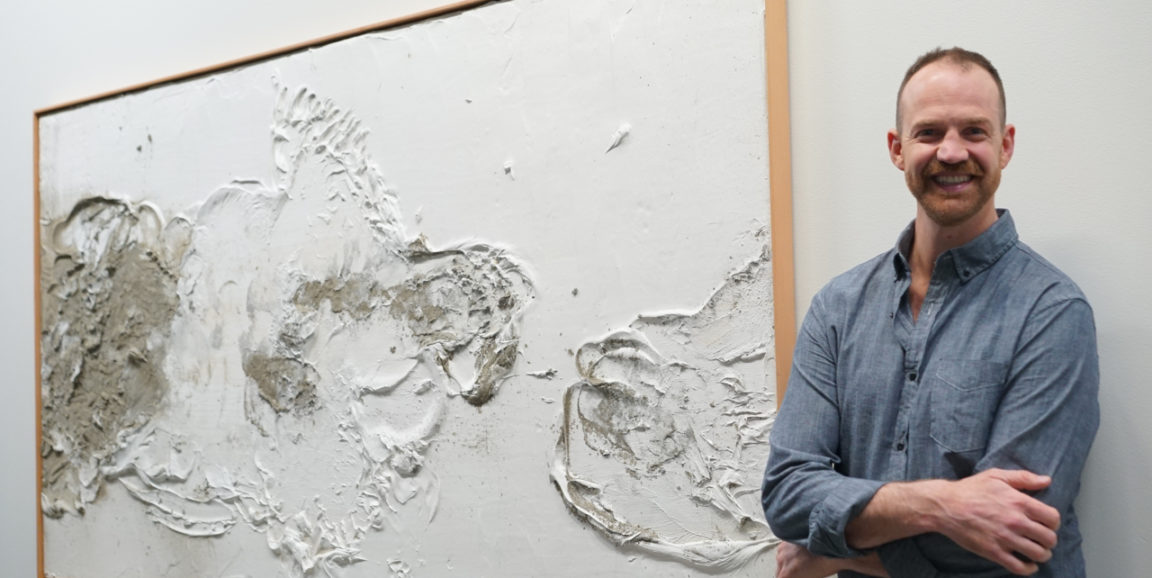Matthew Wetschler, MD, was once nearly dead for ten minutes.
In November 2017 while bodysurfing at Ocean Beach in San Francisco, a wave drove him headfirst into the ocean floor, breaking his neck and leaving him partially paralyzed. He would have drowned had another surfer not spotted him and dragged him to shore, where a vacationing nurse helped resuscitate him. He was transported to Zuckerberg San Francisco General Hospital, where he was the first person in the U.S. to receive a post-experimental treatment focused on maintaining sufficient blood flow within the spinal cord.
That accident and the ensuing months of struggle to ultimately regain movement serve as the inspiration for Wetschler’s new exhibit of paintings, Documenta, now on display at the School of Medicine’s Li Ka Shing Center for Learning and Knowledge (on the first and third floors).
The exhibit documents his recovery, but before you visit (and you should), there are finer points to the story, which I've collected in the notes below. As Wetschler himself noted in our recent conversation, “People want to create an arc of triumph and personal will. That’s too simple a narrative.”
Exhibit Note 1: Wetschler is a philosopher.
Wetschler, who completed residency in emergency medicine at Stanford before the accident, said he was drawn to medicine because of the social and humanist role of the physician. But as an undergraduate, Wetschler majored in philosophy, and the study clearly influences his practice of medicine, his art, and his view of his accident.
“We are in an interesting time,” he explained. “The Enlightenment philosophical approach suggested that through empiric (i.e. scientific) observation and rational thought we could understand the world and find the ultimate truth. But we overestimate the impartial nature of our observations. Even if there is a Truth, post-modern philosophy suggests that we cannot reach it. That it is impossible to escape our subjective experience. I fall somewhere in the middle, trying to find truth while recognizing individual limitation. Ultimately, I’m interested in how we as people experience the world, how do we suffer, how do we survive and heal. Medicine offers a front row seat.”
Exhibit Note 2: Wetschler values rituals.
The death of patients is sadly not an unusual occurrence in emergency medicine, and the protocol is often to call time of death, begin cleaning the room, and turn to the next patient. But when a patient died early in Wetschler’s medical training, a nurse made everyone stop, close the door, turn off the monitors, and observe 60 seconds of silence.
“It was not a religious moment,” Wetschler explains, “but rather the secular application of the mechanism of ritual. Taking 60 seconds and ignoring chaos and need of the emergency room and acknowledging that we as providers are doing something very meaningful. We need space to keep intrinsic values, values that are important to us, present and active.”
Exhibit Note 3: The paintings in Documenta are all done with white paint.
Wetschler created all of the works in the Documenta exhibit in the past year, and they are directly inspired by his accident and the recovery process. They are also exclusively a product of ritual. Wetschler, who still experiences loss of fine-motor coordination in his hands, began each piece with a ritual of repetition that used positioning and stress to create weakness in his hands and arms. Then he painted.
What arrived on the canvas was a direct product of that physical vulnerability (see exhibit note 5) in brush strokes and movement. Wetschler views the ritual itself as the art, and said he felt color would detract from the viewer's comprehension of the ritual.
The location of the exhibition in the School of Medicine also becomes part of the viewer experience.
“There is something cyclical about showing [at Stanford University School of Medicine]. This is an expression of my own healing in the place I learned to become a healer. It becomes a statement of how that is an active process for all of us. Sometimes we are the healer, and sometimes we need to be healed.”
Exhibit Note 4: Pay close attention to the painting called "Reentry."
The first time Wetschler returned to the site of his accident, he brought a canvas but he did not start painting immediately. Instead, he drew a large circle in the sand, walked the 200-foot perimeter as a ritual, then went into the frigid ocean. He repeated this circle-walk and ocean dip 13 times to induce hypothermia and weakness, but surprisingly, he found his final laps were his strongest. He then hurled his body, sand and all, onto a paint-covered canvas. This work is the result.
Exhibit Note 5: We are all vulnerable, and that makes us strong.
After a year of recovery, Wetschler said he plans to return to work as a physician. While he feels his accident may influence his compassion for his patients, more than anything he believes he’s gained a deeper understanding of how vulnerable humans are, and how acknowledging this provides true strength. He adds:
My accident was a manifestation of an individual encountering the chaos of world and his own frailty. We aren’t in control. Things can change at any moment. In emergency medicine, we are exposed to people's vulnerabilities. That requires a certain constitution to face every day and still remain emotionally whole...
The antidote is adopting the perspective that crazy things can happen, and we will always rise to the challenge. Hopefully I’m living proof that even if we break ourselves in some way, we can still move forward. Within us is a deep well of capacity we underestimate. There is strength in acknowledging vulnerability and still persisting.
Photo by Susan Coppa




